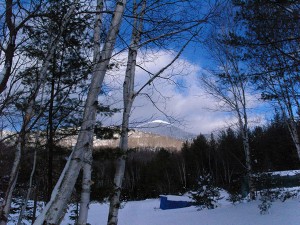Winter tree ID: Buds are your buddies
Every winter I present several tree identification walks to Biology students. Cold or colder, it’s always outdoors, but if the student evaluations are for real, it’s always fun. Demonstrating how to tell one leaf-bereft hardwood from another is one thing; explaining why one should even bother is trickier.
The short answer is, “It’s on the test.” Beyond that there are more interesting and practical reasons. If you’re camping, lost, or stranded—or all of the above—you can get safe drinking water between early March and late June if you know which trees and other woody plants to find. In fall and early winter, knowing a leafless viburnum when you see one may score you some tasty, energy-filled berries.
Want to cut your own firewood? It’s a huge waste of time to fell and buck up a load of poplar or willow. And it’s handy to know that in a pinch you can burn fresh-cut ash and cherry, something you can’t really do with other hardwoods.
Want to start making syrup in your back lot? You’ll have to locate sugar, silver or red maples, all of which yield sweet sap. Tapping your oaks and ash won’t help the cause. If you enjoy woodcarving, you know a prime carving wood is basswood. But its bark can resemble that of other tree species.

It’s easy to ID white birch by its bark; everything else? Not so much. Archive Photo of the Day: George DeChant
Bark in fact is not the best feature for ID. Sure, white bark means birch, but some birches have black, yellow or reddish bark. Typical bark patterns, such as diamond-shaped furrows for ash, can be absent depending on site conditions and tree health. Cherry and ironwood bark have light-colored horizontal dashes called lenticels, but only on young wood. Bark may provide a clue, but it can deceive you.
A better diagnostic tool is arrangement. Don’t get a vase; this means whether twigs grow opposite one another or are alternate on the branch. Most trees are alternates (but not second-rate), so we focus on opposites: maple, ash and dogwood (MAD). The caprifolaceae family includes many shrubs and small trees, giving us “MAD Cap” for the opposites.
Smell and taste are honest indicators, but only for a few species. Twigs of yellow and black birch taste of wintergreen. Peel a cherry twig and you’ll get a whiff of of bitter almond. Red and silver maple can look similar, but the twigs of the latter smell rank when broken. Prickly-ash twigs numb the mouth.
Since all our native dogwoods are shrubs, the opposite-tree category comprises only maple and ash. That would sure narrow things down if not for the liars. Stuff happens to trees. Every twig on an ash or maple branch can be missing its “partner twig” on the other side of the branch. Breakage, fungal cankers, freeze damage and other things will do that, so don’t trust branch arrangement.
Vulcans cannot lie (sorry—Trekkie thing), and neither can the buds. Look closely at a twig—are the buds opposite or alternate? Hopefully our human buds are as honest as are tree buds, which can tell us many things. Size, shape, and location are clues.

Beech have long, lance-like buds. Photo: Peter Birch, Creative Commons, some rights reserved
Beech have long, lance-like buds. Balsam-poplars have sticky, aromatic buds. Red (soft) and silver maples have puffy, reddish buds. Sugar maple buds are brown and conical, like a sugar cone. Oaks have clusters of buds at the end of each twig. “Invisible” black locust buds hide under the bark.
Inside each bud is an embryonic leaf (and/or flower). To protect their tender charges, most tree buds have overlapping scales that open in spring. Basswood buds have few scales, and they vary greatly in size. Sugar maple buds have lots of uniform scales. Butternut and hickory buds have no scales. Even tiny features on scales can be diagnostic. The best winter tree ID tools are the buds. Remember that—it’ll be on the test.
For more details on tree identification, see Cornell’s booklet “Know Your Trees,” available as a free download, or call your Cooperative Extension office.
Paul Hetzler is a horticulture and natural resources educator with Cornell Cooperative Extension of St. Lawrence County.








